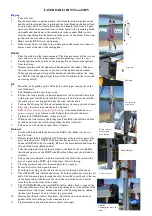
If Child Mode is not activated, the
Test result
screen is displayed immediately after the test is completed.
See
Options in the test result screens
for a description of the buttons available.
Pass/Clear Response
A single frequency
Pass/Clear Response
is determined by a statistical algorithm based
on weighted averaging, which ensures high-sensitivity detection. A
Pass/Clear
Response
result for a single frequency indicates that the patient has normal outer hair
cell function in the corresponding frequency region of the cochlea at the time of test-
ing.
The number of frequencies that must pass in order to achieve A
Pass/Clear Response
result depends on the selected DPOAE protocol. See
Note
•
Retro-cochlear hearing loss cannot be detected by DPOAE testing.
Refer/No Clear Response
In Protocols 1, 2 and 5, a
Refer/No Clear Response
result indicates that in at least 3
frequency bands out of 6, no significant DPOAE response could be detected.
In Protocols 3, 4 and 7, a
Refer/No Clear Response
result indicates that in at least 2
frequency bands out of 4, no significant DPOAE response could be detected.
Protocol 6 does not generate an overall
Pass/Clear Response
or
Refer/No Clear
Response
result.
The DPOAE result specifies each frequency tested. This facilitates decisions con-
cerning further procedures. A
Pass/Clear Response
at a single frequency indicates
near to normal outer hair cell function in the corresponding frequency region of the
cochlea.
The common reasons for non-detection are noisy test conditions or a poor probe fit. In DPOAEs this is especially true for
the lowest frequencies. Therefore, low frequency
Refer/No Clear Response
with high frequency
Pass/Clear Response
is
a strong indicator that test conditions were not optimal. If this is the case, it is recommended that you improve test con-
ditions and repeat the test.
32
Otometrics - MADSEN Alpha OAE+
5 Testing with Alpha OAE+
















































